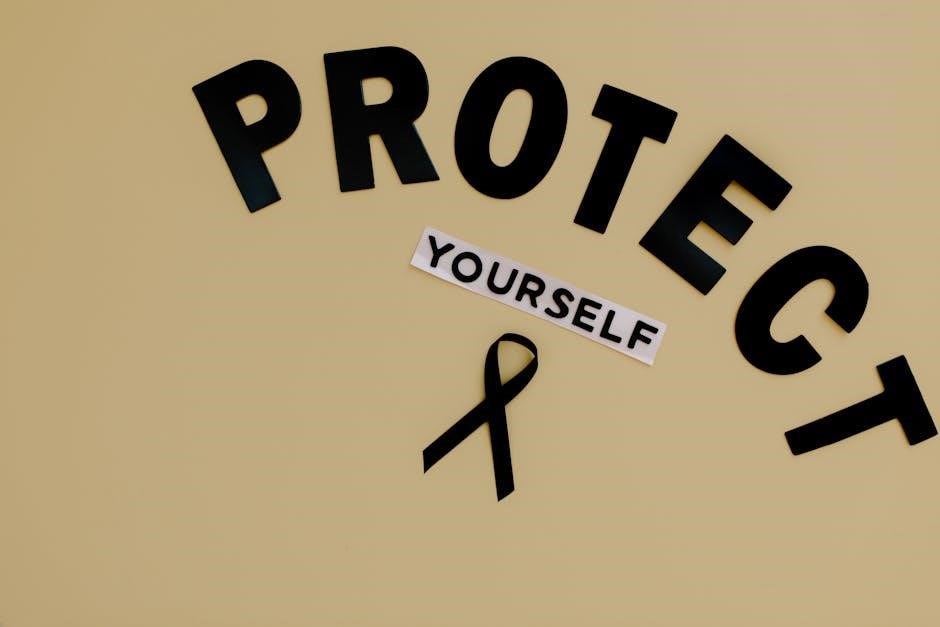Self-advocacy worksheets are practical tools designed to help individuals, especially those with disabilities, develop essential life skills through structured lessons and resources, fostering empowerment and independence․
What Are Self-Advocacy Worksheets?
Self-advocacy worksheets are structured tools designed to help individuals develop skills to effectively communicate their needs, rights, and goals․ These resources often include exercises, prompts, and activities tailored to foster self-awareness, problem-solving, and communication․ They guide users in identifying strengths, weaknesses, and personal goals, while providing scenarios to practice advocating for themselves in real-life situations․ Available in PDF formats, these worksheets are adaptable for various ages and needs, making them versatile tools for educators, healthcare professionals, and individuals seeking to enhance their self-advocacy abilities․
Why Are Self-Advacy Worksheets Important?
Self-advocacy worksheets are essential for empowering individuals to communicate their needs, rights, and goals effectively․ They enhance self-awareness, problem-solving, and communication skills, fostering independence and confidence; These tools provide structured exercises to identify strengths, weaknesses, and personal goals, while offering scenarios to practice real-life advocacy․ By improving decision-making and social interactions, they promote personal growth and autonomy․ Available in PDF formats, they are accessible to diverse audiences, making them invaluable for educators, healthcare professionals, and individuals seeking to enhance their self-advocacy abilities and overall well-being․

The Three-Step Self-Advocacy Process
The process involves scanning and naming challenges, identifying solutions, and communicating effectively․ These steps empower individuals to address needs, develop strategies, and express themselves confidently in various situations․
Step 1: Scan and Name
Step 1 involves identifying and naming challenges or needs․ Individuals reflect on what matters to them, recognizing issues they face․ This step raises self-awareness, helping them articulate their thoughts and feelings clearly․ Worksheets guide users to list strengths, weaknesses, and goals, fostering clarity and focus․ By naming their challenges, individuals prepare to address them effectively․ This foundational step empowers them to take control of their needs and develop targeted solutions, setting the stage for meaningful self-advocacy․ It encourages honesty and self-reflection, essential for personal growth and problem-solving․
Step 2: Identify Solutions
Step 2 focuses on generating and evaluating potential solutions to identified challenges․ Worksheets guide users to brainstorm ideas, consider pros and cons, and select the most effective strategies․ This step encourages critical thinking and creativity, helping individuals develop problem-solving skills․ By exploring various options, users gain confidence in their ability to address issues․ Worksheets often include exercises like scenario analysis or decision-making grids to support this process, fostering independence and empowering individuals to take action toward resolving their challenges effectively․
Step 3: Communicate
Step 3 focuses on effectively expressing needs and desires through clear and assertive communication․ Worksheets include exercises to practice active listening, assertive speaking, and non-verbal cues․ Role-playing activities and reflection exercises help users refine their communication skills․ This step emphasizes the importance of confidence and clarity in conveying thoughts and feelings․ By mastering communication, individuals can advocate for themselves effectively, ensuring their voices are heard and their needs are met in various situations, from personal to professional settings․

Key Components of Self-Advocacy
Self-advocacy relies on self-awareness, communication skills, and problem-solving abilities․ These components empower individuals to express their needs, make informed decisions, and navigate challenges confidently and effectively․
Self-Awareness and Self-Understanding
Self-awareness and self-understanding are foundational to self-advocacy, enabling individuals to recognize their strengths, weaknesses, and needs․ Worksheets often include exercises to identify personal strengths and areas for growth, fostering a deeper understanding of oneself․ This self-awareness helps individuals communicate their needs effectively and assert their rights confidently․ By understanding their values, preferences, and challenges, individuals can make informed decisions and advocate for themselves in various settings, such as education, healthcare, and the workplace․ Self-awareness is the cornerstone of effective self-advocacy, empowering individuals to take control of their lives and express their needs clearly․
Communication Skills
Effective communication is a critical component of self-advocacy, enabling individuals to express their needs, desires, and concerns clearly․ Worksheets often include exercises to practice active listening, assertive speaking, and non-verbal communication, such as using “I” statements and maintaining eye contact․ These skills help individuals navigate conversations confidently, whether in educational, healthcare, or workplace settings․ By improving communication, self-advocacy worksheets empower individuals to articulate their thoughts effectively, ensuring their voices are heard and their rights are respected; Strong communication fosters understanding and collaboration, leading to more positive outcomes․
Problem-Solving and Critical Thinking
Self-advocacy worksheets often include exercises that enhance problem-solving and critical thinking skills, enabling individuals to analyze challenges and develop effective solutions․ These tools encourage users to identify barriers, brainstorm alternatives, and evaluate outcomes․ By practicing these skills, individuals can approach real-life scenarios with confidence, making informed decisions that align with their needs and goals․ Critical thinking fosters independence, allowing self-advocates to navigate complex situations and assert their rights effectively in various settings, from education to healthcare and beyond․
Examples of Self-Advocacy Worksheets
Self-advocacy worksheets include tools like identifying strengths/weaknesses, effective communication exercises, and problem-solving scenarios, helping users set personal goals and communicate their needs clearly in various situations․
Strengths, Weaknesses, Needs, and Goals Worksheet
This worksheet helps individuals identify their personal strengths, areas for improvement, and specific needs․ It also guides users in setting realistic, achievable goals related to self-advocacy․ By reflecting on these aspects, users gain clarity about their abilities and challenges, fostering self-awareness and personal growth․ The worksheet includes sections for listing strengths, weaknesses, and needs, followed by a goal-setting section to develop a clear plan for improvement․ This tool is particularly effective for individuals with disabilities, helping them articulate their requirements and aspirations effectively;
Effective Communication Skills Worksheet
This worksheet focuses on enhancing communication skills, a cornerstone of self-advocacy․ It includes exercises on active listening, assertive speaking, and understanding non-verbal cues․ Users practice articulating their needs clearly and respectfully, while also learning to interpret others’ communication styles․ Reflection questions and scenario-based activities help individuals refine their ability to express feelings and concerns effectively․ By mastering these skills, users can navigate social and professional interactions with confidence, ensuring their voices are heard and understood in various situations․
Problem-Solving Scenarios Worksheet
This worksheet presents real-life scenarios that require critical thinking and problem-solving skills․ Users analyze situations, identify potential barriers, and develop practical solutions․ It encourages individuals to apply self-advocacy skills to navigate challenges effectively․ The exercises help build confidence in decision-making and empower users to address issues independently․ By practicing these scenarios, individuals refine their ability to think critically and advocate for themselves in various contexts, fostering greater independence and self-efficacy in their daily lives․

How to Use Self-Advocacy Worksheets Effectively
Start by setting personal goals and reflecting on progress․ Engage in role-playing exercises to practice real-life scenarios․ Seek feedback and support to refine skills and strategies effectively․
Setting Personal Goals and Reflecting on Progress
Setting personal goals is a cornerstone of self-advocacy․ Worksheets help individuals identify strengths, weaknesses, and areas for improvement, enabling them to set realistic objectives․ Reflecting on progress allows users to track growth, celebrate achievements, and adjust goals as needed․ This structured approach fosters self-awareness and accountability, empowering individuals to take ownership of their development․ Regular reflection also enhances problem-solving skills and builds confidence, making self-advocacy more effective in various life situations, from education to personal relationships․
Engaging in Role-Playing and Practical Exercises
Role-playing and practical exercises are dynamic tools for enhancing self-advocacy skills․ By simulating real-life scenarios, individuals practice communicating their needs confidently․ These exercises build problem-solving abilities, helping users navigate social interactions effectively․ Hands-on activities provide tangible experiences, reinforcing learning and boosting independence․ Regular engagement fosters improved decision-making and assertiveness, equipping individuals to advocate for themselves in diverse situations, from school to personal relationships, with greater ease and confidence․
Seeking Feedback and Support
Seeking feedback and support is crucial for refining self-advocacy skills․ Sharing completed worksheets with educators, peers, or support groups provides valuable insights and encouragement․ Educators and healthcare professionals can offer guidance, helping individuals identify strengths and areas for improvement․ Regular feedback fosters confidence and accountability, enabling individuals to track progress and adjust their strategies․ This collaborative approach ensures continuous growth and empowers individuals to advocate for themselves effectively in various life situations․

The Role of Educators and Healthcare Professionals
Educators and healthcare professionals play a vital role in teaching self-advocacy skills, fostering independence, and empowering individuals to communicate their needs effectively in various settings․
Teaching Self-Advocacy in Educational Settings
Educators play a crucial role in introducing self-advocacy worksheets to students, helping them develop essential skills like communication and problem-solving․ These tools enable students to identify their strengths, weaknesses, and goals, fostering self-awareness and confidence․ By incorporating worksheets into lesson plans, teachers can create structured learning opportunities that promote independence and empowerment․ Role-playing exercises and scenario-based activities further enhance practical application, ensuring students are prepared to advocate for themselves in real-life situations․ This approach is particularly beneficial for students with disabilities, fostering inclusion and personal growth․
Empowering Patients Through Self-Advocacy
Self-advocacy worksheets empower patients to communicate their needs effectively, fostering better healthcare outcomes․ These tools help patients identify their strengths, challenges, and goals, enabling them to express preferences and concerns clearly․ By practicing active listening and assertive communication, patients gain confidence in navigating their care․ Worksheets also encourage patients to reflect on their experiences, promoting self-awareness and autonomy․ This approach strengthens the patient-provider relationship, ensuring personalized and patient-centered care, ultimately improving overall well-being and satisfaction․
Self-advocacy worksheets are invaluable tools for fostering independence and confidence․ Resources like downloadable PDFs from educational and advocacy websites provide accessible support for personal growth and empowerment․
Benefits of Self-Advocacy Worksheets
Self-advocacy worksheets offer numerous benefits, fostering critical life skills like self-awareness, decision-making, and problem-solving․ They empower individuals to communicate effectively, set boundaries, and advocate for their needs․ These tools enhance social interactions, build confidence, and promote independence, particularly for those with disabilities․ By providing structured exercises, they help users reflect on strengths, weaknesses, and goals, leading to personal growth․ Worksheets are versatile, benefiting children, teens, and adults in educational, therapeutic, and professional settings, making them invaluable for lifelong skill development and empowerment․
Where to Find Self-Advocacy Worksheets in PDF Format
Self-advocacy worksheets in PDF format are widely available online through educational platforms, disability resource websites, and advocacy organizations․ Websites like the Oklahoma Parent Teacher Association and CarePatron offer free downloadable templates․ These resources often include structured exercises for self-awareness, communication, and problem-solving․ Additionally, platforms like Freepik provide accessible templates for personal or professional use․ Users can easily search for “self-advocacy worksheets PDF” to find customizable materials suitable for various settings, including schools, therapy sessions, and personal development programs․
